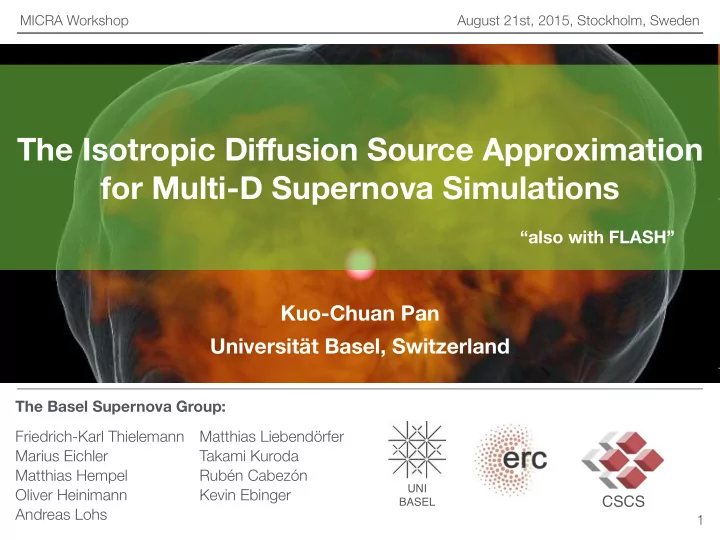

MICRA Workshop August 21st, 2015, Stockholm, Sweden The Isotropic Di ff usion Source Approximation for Multi-D Supernova Simulations “also with FLASH” Kuo-Chuan Pan Universität Basel, Switzerland The Basel Supernova Group: Friedrich-Karl Thielemann Matthias Liebendörfer Marius Eichler Takami Kuroda Matthias Hempel Rubén Cabezón UNI Oliver Heinimann Kevin Ebinger CSCS BASEL Andreas Lohs 1
Basic Physics ‣ Direct hydrodynamics mechanism always fail! ‣ Neutrino-driven convection is the key ˙ p ˙ M M e − e + R shock ν e p n ¯ ν e n R gain PNS R ν R NS Adapted from Janka 01 RIKEN 2015.08 MICRA 2015 Kuo-Chuan Pan 2
Isotropic Diffusion Source Approximation (IDSA) IDSA (Liebendorfer+ 09) Liebendorfer+ 09 PNS ν e Opaque Semi-transparent Transparent Kuo-Chuan Pan MICRA 2015 3
Multi-D Simulations with IDSA ‣ Multi-dimensional simulations with the IDSA have been studied by the Nippon groups ‣ ZEUS+IDSA in spherical coordinates with Ray-by-Ray approach Takiwaki+ 14 Suwa+ 13 Nakamura+ 14 Kuo-Chuan Pan MICRA 2015 4
Multi-D IDSA with FLASH Spherical Symmetry: R ν ( E, l ) f s ( E, l ) Liebendorfer+ 09 PNS ν e Opaque Semi-transparent Transparent Kuo-Chuan Pan MICRA 2015 5
FLASH+IDSA ‣ 2D cylindrical and 3D Cartesian coordinates with AMR: better PNS but noisy ‣ Not “Ray-by-Ray” approach. We solve the diffusion source and trapped particle component in multi-dimensions, but keep the streaming component in spherical symmetry (Similar to the Elephant code) ‣ 20 energy bins from 3 MeV to 300 MeV ‣ Only for electron type neutrinos (Heavy neutrinos -> Leakage scheme) Ray-by-Ray Full 3D Ott+ 12 This work Kuo-Chuan Pan MICRA 2015 6
The FLASH code (v4.2.2) Code Status: ‣ Geometry: 1D spherical, 2D cylindrical, and 3D Cartesian (Similar to Couch+13) ‣ Hydrodynamics: 3rd PPM with HLLC Riemann solver with AMR ‣ Resolution: effective angular resolution (2D:~0.3-0.6 0 ,3D:~1-2 0 ) ‣ Simulation box: r= 0 to r= 10,000 km ‣ Gravity: The new improved multi-pole solver (Couch+13; Newtonian or eff. GR) ‣ EoS: Supernova EoS from http://stellarcollapse.org ‣ Neutrino transport: Isotropic Diffusion Source Approximation (IDSA) ‣ Collapse: IDSA or parametrized deleptonization ( PD ; Liebendorfer+05) ‣ Postbounce: IDSA (Liebendorfer+09) Kuo-Chuan Pan MICRA 2015 7
1D Code Comparison: FLASH v.s. AGILE Shock Radius Neutrino Spectra W2002 Progenitors + LS220 s15.0 Kuo-Chuan Pan MICRA 2015 8
1D Code Comparison: Eff. GR s15s7b2 (W1995) + LS180 Marek+06 Preliminary Shock Radius Shock Radius O’Connor+ 15 Neutrino Luminosity Neutrino Luminosity Preliminary Kuo-Chuan Pan MICRA 2015 9
The Bruenn rates (1985) in IDSA s15 (W2007) + LS220 Neutrino Luminosity Neutrino Luminosity Shock Radius Preliminary Preliminary Neutrino Luminosity Lentz+ 12 Lentz+ 12 Shock Radius Kuo-Chuan Pan MICRA 2015 10
2D Code Comparison The 2007 (WHW) Progenitors Hanke 14 Bruenn +13 Suwa +14 Dolence+15 Kuo-Chuan Pan MICRA 2015 11
2D Code Comparison The 2007 (WHW) Progenitors Hanke 14 Preliminary Suwa +14 Bruenn +13 Dolence+15 Kuo-Chuan Pan MICRA 2015 12
2D Code Comparison Dolence+15 FLASH+IDSA Hanke 14 Melson+15 s15 s20 Preliminary s20 Preliminary NR+ShenEoS NR+LS220 GR+LS220 Kuo-Chuan Pan MICRA 2015 13
2D: W2002 Progenitors DD2 vs. LS220 FLASH+IDSA+DD2 Pan+15 The HS(DD2) EoS The new SN EoS HS (DD2) shows a better agreement with nuclear experiments (Kruger+13; Fischer+14; Hempel+15) Kuo-Chuan Pan MICRA 2015 14
2D Results: SASI Pole Entropy SASI Amplitude Kuo-Chuan Pan MICRA 2015 15
2D Results: Convection-Driven Brunt-Vaisala Frequenciy Anisotropic Velocity Kuo-Chuan Pan MICRA 2015 16
2D vs. 3D Melson+15 Takiwaki+14 Lentz+15 s11.2 (W02) s15.0 (W07) u9.6 (W15) Muller+13 s20.0 (W07) Kuo-Chuan Pan MICRA 2015 17
3D FLASH-IDSA results Pan+ in prep. ‣ 3D IDSA+PD ‣ 15M sun (WHW+02) ‣ HS (DD2) EoS ‣ Newtonian ‣ Resolution: 1.8 0 ‣ Only 0.5M cpu-hours s15.0 IDSA s15.0 w PD Kuo-Chuan Pan MICRA 2015 18
3D simulations with the 15.0 progenitor Lentz+15 Pan+ in prep. s15.0 (W07) LS220 s15.0 (W02) DD2 Note that the physics employed and the progenitors used are different Kuo-Chuan Pan MICRA 2015 19
2D vs. 3D (conti.) Kuo-Chuan Pan MICRA 2015 20
Neutrino Heating in 3D 2D 3D 150 ms 250 ms 300 ms 500 km Kuo-Chuan Pan MICRA 2015 21
Conclusions ‣ Our IDSA implementation seems robust (or too optimistic; all 2D and 3D models exploded) with diagnostic explosion energies ~0.1-0.5 B (at ~400ms) ‣ Neutrino interactions (e.g. NES) during collapse are important in Multi-D ‣ Neutrino-driven convection with little SASI (W2002 Progenitors) ‣ DD2 is slightly easier to explode than LS220 ‣ 3D seems harder to explode than 2D ‣ IDSA is promising to achieve high-resolution 3D simulations (good for progenitor studies, long-term evolutions and nuclear synthesis) Kuo-Chuan Pan MICRA 2015 22
EoS Dependence 9 EoS from StellarCollapse with the s15.0 (W2002) progenitor 1D 2D ~600km ~50ms Kuo-Chuan Pan MICRA 2015 23
3D Code comparison Elephant SPHYNX 3D IDSA ASL/IDSA Cartesian mesh SPH NR/ eff. GR 3D Newtonian FLASH fGR_M1 1-3D IDSA M1 AMR Nested meshes NR/eff. GR 3D full GR Kuo-Chuan Pan MICRA 2015 24
2D vs. 3D Time = 400 ms Time = 200 ms Time = 300 ms Time = 400 ms Lentz+15 Kuo-Chuan Pan MICRA 2015 25
Recommend
More recommend